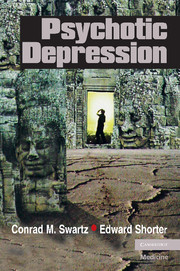Book contents
- Frontmatter
- Contents
- Preface
- Acknowledgments
- Chapter 1 Introduction
- Chapter 2 History of Psychotic Depression
- Chapter 3 Diagnosis in Psychotic Depression
- Chapter 4 Patients' Experience of Illness
- Chapter 5 Treatment in Historical Perspective
- Chapter 6 Treatment: Pitfalls and Pathways
- Chapter 7 Treatment: ECT, Medications, and More
- Chapter 8 Treatment by Type of Psychotic Depression
- Appendix 1 Summary Guide to Psychiatric Concepts
- Appendix 2 Summary Guide to Psychotropic Medication and Treatment
- References
- Index
Chapter 6 - Treatment: Pitfalls and Pathways
Published online by Cambridge University Press: 10 September 2009
- Frontmatter
- Contents
- Preface
- Acknowledgments
- Chapter 1 Introduction
- Chapter 2 History of Psychotic Depression
- Chapter 3 Diagnosis in Psychotic Depression
- Chapter 4 Patients' Experience of Illness
- Chapter 5 Treatment in Historical Perspective
- Chapter 6 Treatment: Pitfalls and Pathways
- Chapter 7 Treatment: ECT, Medications, and More
- Chapter 8 Treatment by Type of Psychotic Depression
- Appendix 1 Summary Guide to Psychiatric Concepts
- Appendix 2 Summary Guide to Psychotropic Medication and Treatment
- References
- Index
Summary
Before the advent of antidepressant drugs and ect, patients with depression generally recovered spontaneously, excepting those with psychotic depression who often suffered chronically (Kantor and Glassman, 1977). This historical perspective continues to direct our concern about the fate of patients with undertreated psychotic depression.
With prompt treatment psychotic depression should generally remit, becoming an episode with a beginning and an end. In between episodes the patient should be able to pursue work, creative endeavors, and pleasure without impairment. Yet, many patients do not recover fully, and the alternative outcomes range from misery to disability, entailing years of quiet impairment. Delay in providing effective treatment risks the emergence of PTSD from the stigmatizing, debilitating, and often life-threatening experiences of psychotic depression, psychiatric confinement, tranquilizing drugs, and the reactions of others to the patient's vicissitudes. Moreover, PTSD itself is agonizing, impairing, and decidedly chronic. If psychotic depression is undertreated, one risks the chronicization of psychotic symptoms. Yet whether the cause is chronicization or PTSD, the longer the period between the onset of the first psychotic symptom and the treatment the worse the outcome, regardless of the actual diagnosis (Marshall et al., 2005).
Treatment of psychotic depression should match the exact type of the illness, as detailed in the diagnosis section (Chapter 8). Unfortunately, the literature on this subject has not considered the types of psychotic depression. Moreover, the descriptions of patients in reported studies are often not detailed enough to identify the type of psychotic depression involved.
- Type
- Chapter
- Information
- Psychotic Depression , pp. 167 - 191Publisher: Cambridge University PressPrint publication year: 2007

